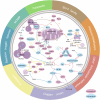New insights into constitutive neutrophil death
- PMID: 39800780
- PMCID: PMC11725587
- DOI: 10.1038/s41420-025-02287-1
New insights into constitutive neutrophil death
Abstract
Neutrophils undergo rapid aging and death known as constitutive or spontaneous death. Constitutive neutrophil death (CND) contributes to neutrophil homeostasis and inflammation resolution. CND has long been considered to be apoptotic until our findings reveal that it was a heterogeneous combination of diverse death. Furthermore, dead neutrophils retain functional roles via multiple manners. This review provides an overview of current research on the mechanism and modulation of CND. More noteworthy, we also summarize the after-death events of neutrophils. The fate of neutrophils can be changed under pathological conditions, so the involvement of CND in diseases and CND-related therapeutic strategies are also addressed.
© 2025. The Author(s).
Conflict of interest statement
Competing interests: The authors declare no competing interests.
Figures



Similar articles
-
Constitutive neutrophil apoptosis: mechanisms and regulation.Am J Hematol. 2008 Apr;83(4):288-95. doi: 10.1002/ajh.21078. Am J Hematol. 2008. PMID: 17924549 Review.
-
Neutrophil sub-types in maintaining immune homeostasis during steady state, infections and sterile inflammation.Inflamm Res. 2023 Jun;72(6):1175-1192. doi: 10.1007/s00011-023-01737-9. Epub 2023 May 22. Inflamm Res. 2023. PMID: 37212866 Free PMC article. Review.
-
Targeting Neutrophils for Promoting the Resolution of Inflammation.Front Immunol. 2022 Mar 16;13:866747. doi: 10.3389/fimmu.2022.866747. eCollection 2022. Front Immunol. 2022. PMID: 35371088 Free PMC article. Review.
-
Neutrophil heterogeneity and fate in inflamed tissues: implications for the resolution of inflammation.Am J Physiol Cell Physiol. 2020 Sep 1;319(3):C510-C532. doi: 10.1152/ajpcell.00181.2020. Epub 2020 Jul 15. Am J Physiol Cell Physiol. 2020. PMID: 32667864 Free PMC article.
-
Dysregulation of neutrophil death in sepsis.Front Immunol. 2022 Aug 18;13:963955. doi: 10.3389/fimmu.2022.963955. eCollection 2022. Front Immunol. 2022. PMID: 36059483 Free PMC article. Review.
Cited by
-
Autophagy: a double-edged sword in ischemia-reperfusion injury.Cell Mol Biol Lett. 2025 Apr 7;30(1):42. doi: 10.1186/s11658-025-00713-x. Cell Mol Biol Lett. 2025. PMID: 40197222 Free PMC article. Review.
References
-
- Ley K, Hoffman HM, Kubes P, Cassatella MA, Zychlinsky A, Hedrick CC, et al. Neutrophils: New insights and open questions. Sci. Immunol. 2018;3:eaat4579. - PubMed
-
- Hidalgo A, Chilvers ER, Summers C, Koenderman L. The Neutrophil Life Cycle. Trends Immunol. 2019;40:584–97. - PubMed
-
- Luo HR, Loison F. Constitutive neutrophil apoptosis: mechanisms and regulation. Am. J. Hematol. 2008;83:288–95. - PubMed
Publication types
Grants and funding
- 82171756/National Natural Science Foundation of China (National Science Foundation of China)
- 2022-I2M-JB-015/Chinese Academy of Medical Sciences (CAMS)
- 2021-I2M-1-040/Chinese Academy of Medical Sciences (CAMS)
- 22JCYBJC01120/Natural Science Foundation of Tianjin City (Natural Science Foundation of Tianjin)
LinkOut - more resources
Full Text Sources

